A Critical Evaluation of Recruitment and Selection at The Lego Group
VerifiedAdded on 2023/05/29
|19
|3465
|384
Report
AI Summary
This report provides an in-depth evaluation of The Lego Group's recruitment and selection approaches. It begins with an overview of Lego's current practices, including its use of its website, job portals, and campus placements for recruitment. The report then delves into a theoretical analysis of good practices in recruitment and selection, drawing from various literatures and guidelines, such as those from the Victorian Public Sector Commission and the Australian Human Rights Commission. These best practices encompass planning, recruitment strategies, short-listing, application processes, testing, interviewing, and decision-making. A critical analysis and evaluation of Lego's approach is then presented, comparing it against these best practices to identify gaps and areas for improvement. Finally, the report concludes with specific recommendations for The Lego Group to enhance its recruitment and selection processes, ensuring a more effective and streamlined approach to talent acquisition and retention.
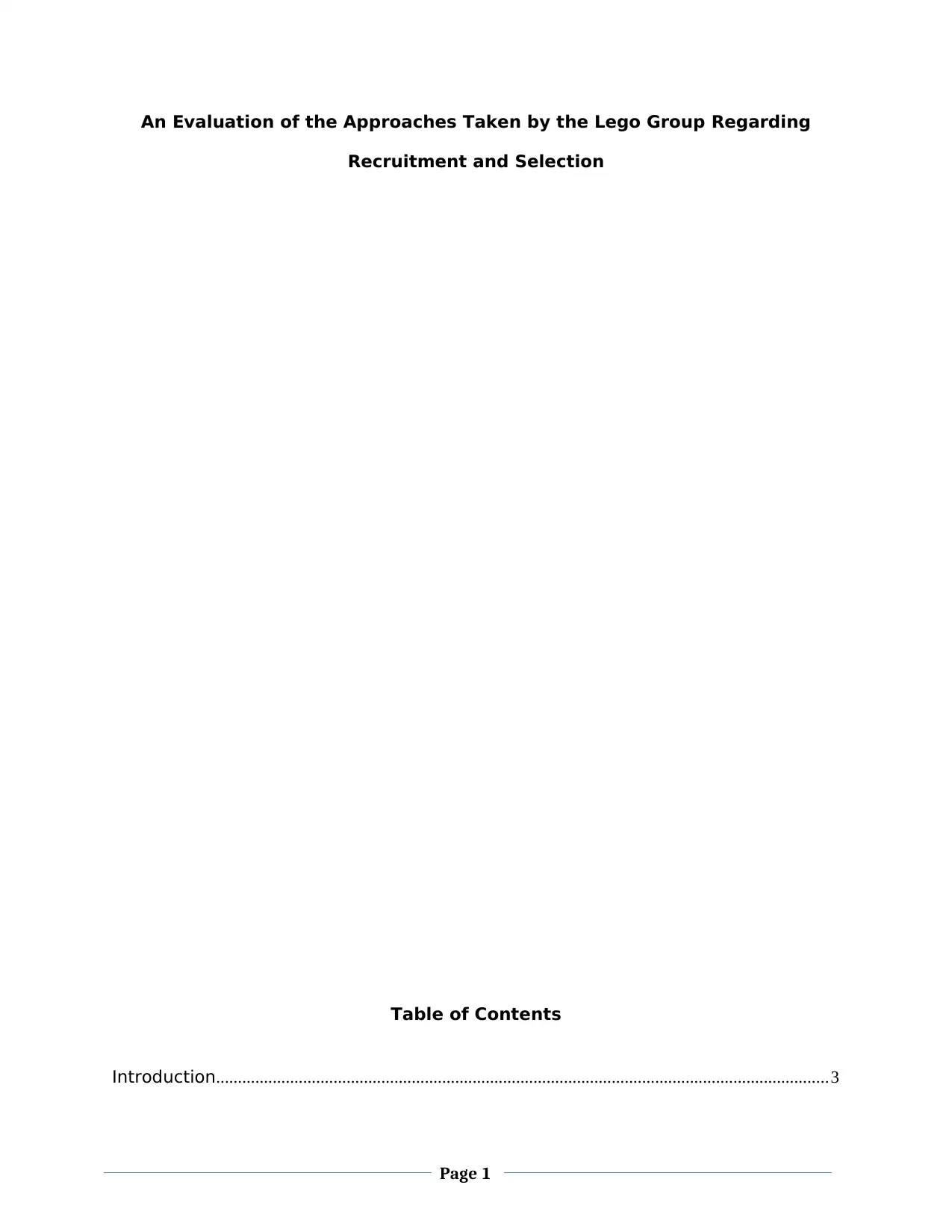
An Evaluation of the Approaches Taken by the Lego Group Regarding
Recruitment and Selection
Table of Contents
Introduction.............................................................................................................................................3
Page 1
Recruitment and Selection
Table of Contents
Introduction.............................................................................................................................................3
Page 1
Paraphrase This Document
Need a fresh take? Get an instant paraphrase of this document with our AI Paraphraser
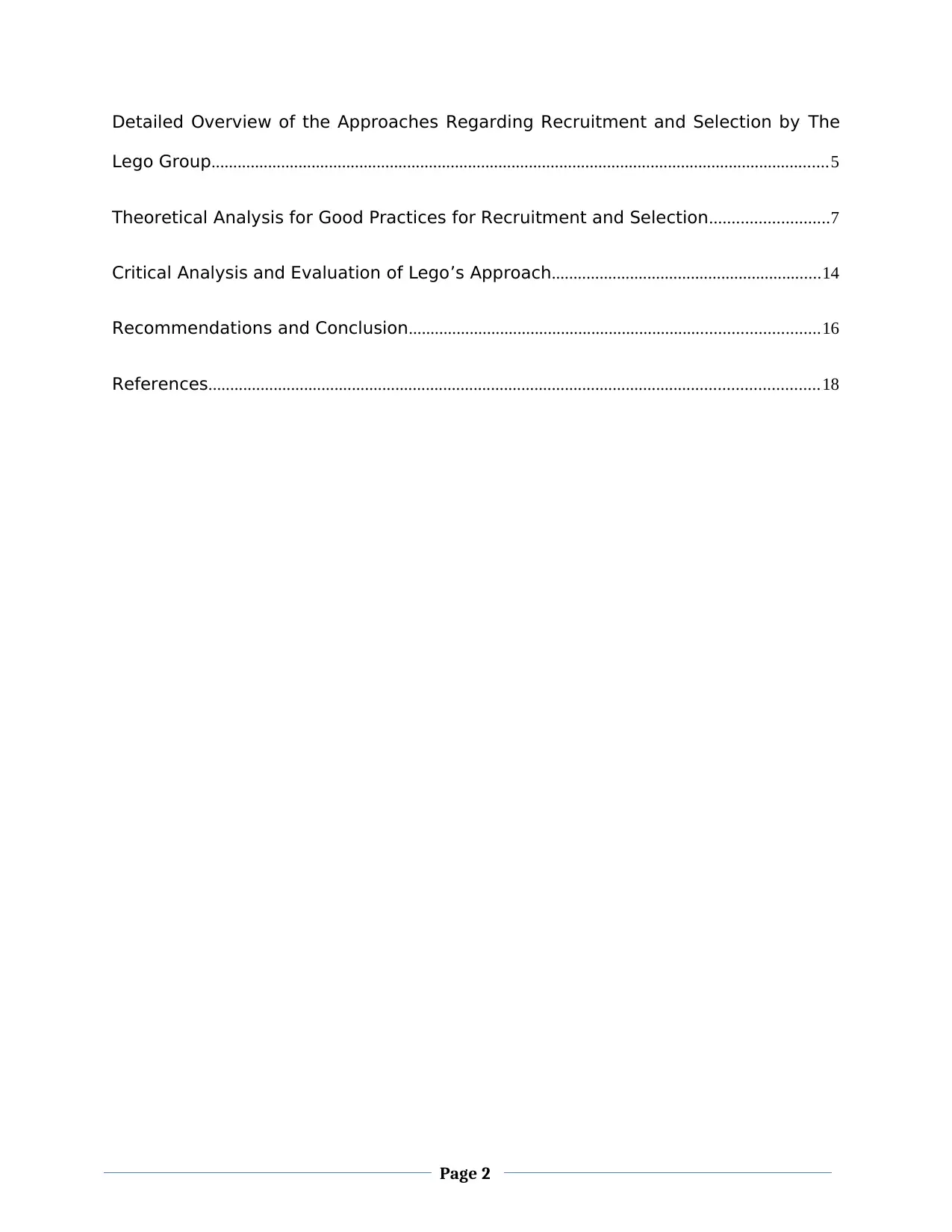
Detailed Overview of the Approaches Regarding Recruitment and Selection by The
Lego Group..............................................................................................................................................5
Theoretical Analysis for Good Practices for Recruitment and Selection...........................7
Critical Analysis and Evaluation of Lego’s Approach..............................................................14
Recommendations and Conclusion..............................................................................................16
References............................................................................................................................................18
Page 2
Lego Group..............................................................................................................................................5
Theoretical Analysis for Good Practices for Recruitment and Selection...........................7
Critical Analysis and Evaluation of Lego’s Approach..............................................................14
Recommendations and Conclusion..............................................................................................16
References............................................................................................................................................18
Page 2
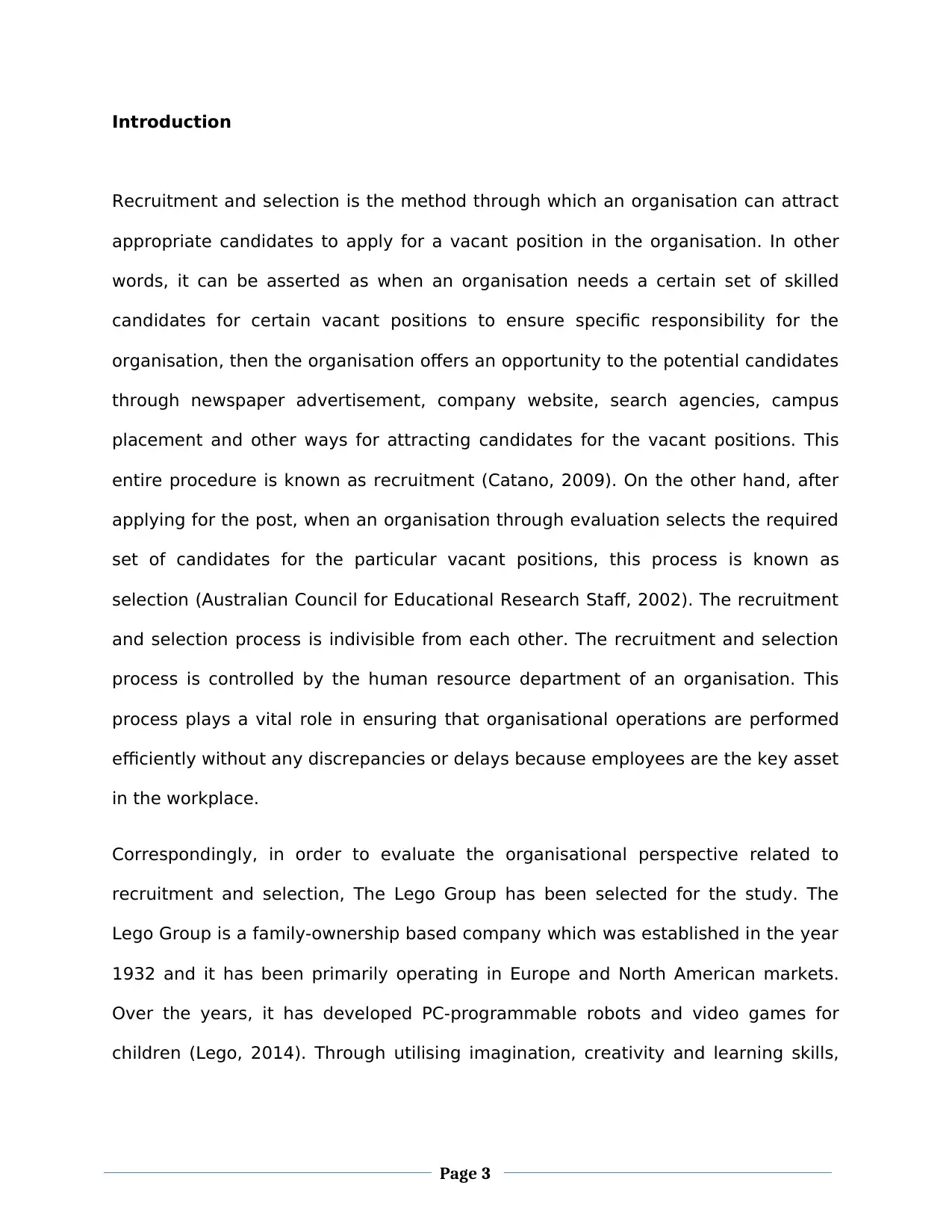
Introduction
Recruitment and selection is the method through which an organisation can attract
appropriate candidates to apply for a vacant position in the organisation. In other
words, it can be asserted as when an organisation needs a certain set of skilled
candidates for certain vacant positions to ensure specific responsibility for the
organisation, then the organisation offers an opportunity to the potential candidates
through newspaper advertisement, company website, search agencies, campus
placement and other ways for attracting candidates for the vacant positions. This
entire procedure is known as recruitment (Catano, 2009). On the other hand, after
applying for the post, when an organisation through evaluation selects the required
set of candidates for the particular vacant positions, this process is known as
selection (Australian Council for Educational Research Staff, 2002). The recruitment
and selection process is indivisible from each other. The recruitment and selection
process is controlled by the human resource department of an organisation. This
process plays a vital role in ensuring that organisational operations are performed
efficiently without any discrepancies or delays because employees are the key asset
in the workplace.
Correspondingly, in order to evaluate the organisational perspective related to
recruitment and selection, The Lego Group has been selected for the study. The
Lego Group is a family-ownership based company which was established in the year
1932 and it has been primarily operating in Europe and North American markets.
Over the years, it has developed PC-programmable robots and video games for
children (Lego, 2014). Through utilising imagination, creativity and learning skills,
Page 3
Recruitment and selection is the method through which an organisation can attract
appropriate candidates to apply for a vacant position in the organisation. In other
words, it can be asserted as when an organisation needs a certain set of skilled
candidates for certain vacant positions to ensure specific responsibility for the
organisation, then the organisation offers an opportunity to the potential candidates
through newspaper advertisement, company website, search agencies, campus
placement and other ways for attracting candidates for the vacant positions. This
entire procedure is known as recruitment (Catano, 2009). On the other hand, after
applying for the post, when an organisation through evaluation selects the required
set of candidates for the particular vacant positions, this process is known as
selection (Australian Council for Educational Research Staff, 2002). The recruitment
and selection process is indivisible from each other. The recruitment and selection
process is controlled by the human resource department of an organisation. This
process plays a vital role in ensuring that organisational operations are performed
efficiently without any discrepancies or delays because employees are the key asset
in the workplace.
Correspondingly, in order to evaluate the organisational perspective related to
recruitment and selection, The Lego Group has been selected for the study. The
Lego Group is a family-ownership based company which was established in the year
1932 and it has been primarily operating in Europe and North American markets.
Over the years, it has developed PC-programmable robots and video games for
children (Lego, 2014). Through utilising imagination, creativity and learning skills,
Page 3
⊘ This is a preview!⊘
Do you want full access?
Subscribe today to unlock all pages.

Trusted by 1+ million students worldwide
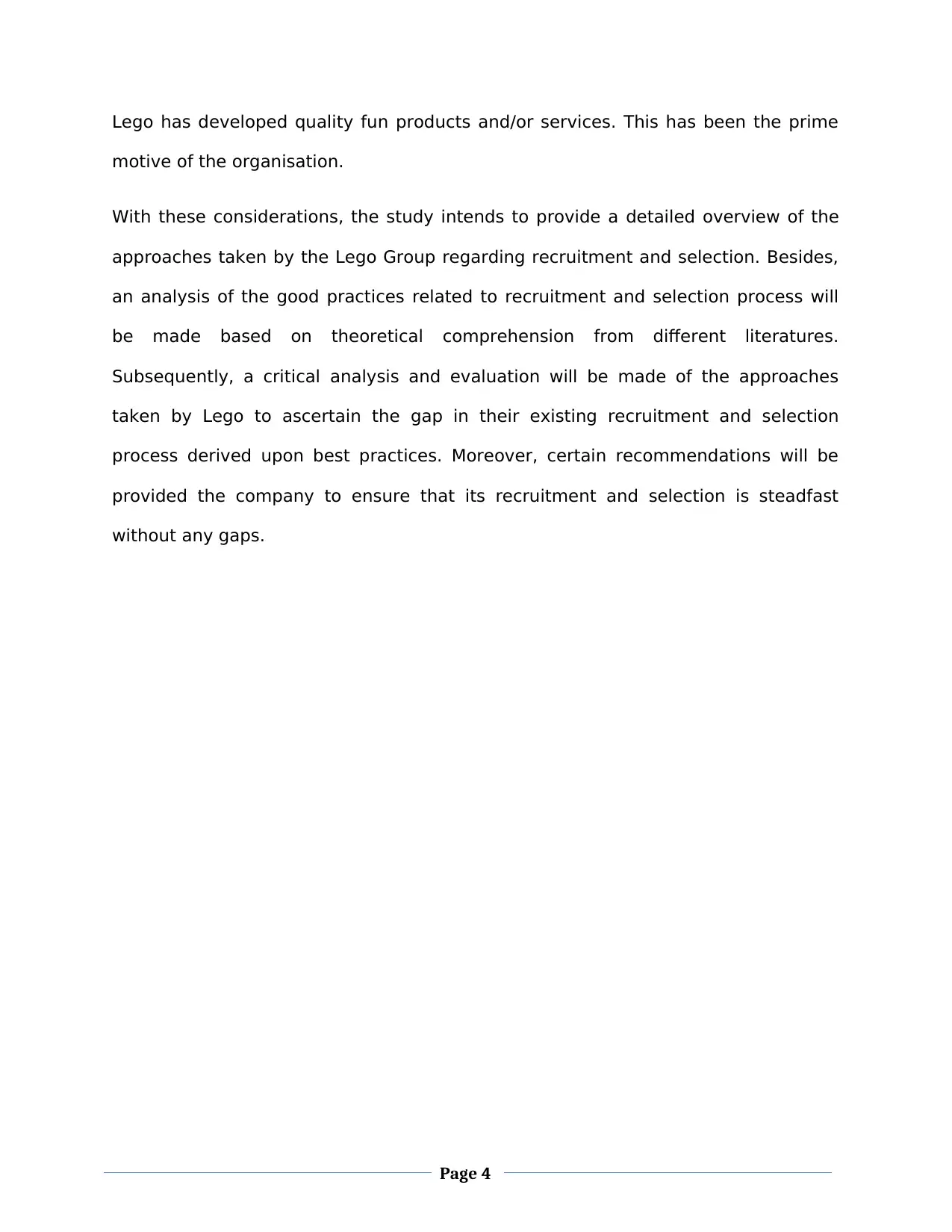
Lego has developed quality fun products and/or services. This has been the prime
motive of the organisation.
With these considerations, the study intends to provide a detailed overview of the
approaches taken by the Lego Group regarding recruitment and selection. Besides,
an analysis of the good practices related to recruitment and selection process will
be made based on theoretical comprehension from different literatures.
Subsequently, a critical analysis and evaluation will be made of the approaches
taken by Lego to ascertain the gap in their existing recruitment and selection
process derived upon best practices. Moreover, certain recommendations will be
provided the company to ensure that its recruitment and selection is steadfast
without any gaps.
Page 4
motive of the organisation.
With these considerations, the study intends to provide a detailed overview of the
approaches taken by the Lego Group regarding recruitment and selection. Besides,
an analysis of the good practices related to recruitment and selection process will
be made based on theoretical comprehension from different literatures.
Subsequently, a critical analysis and evaluation will be made of the approaches
taken by Lego to ascertain the gap in their existing recruitment and selection
process derived upon best practices. Moreover, certain recommendations will be
provided the company to ensure that its recruitment and selection is steadfast
without any gaps.
Page 4
Paraphrase This Document
Need a fresh take? Get an instant paraphrase of this document with our AI Paraphraser
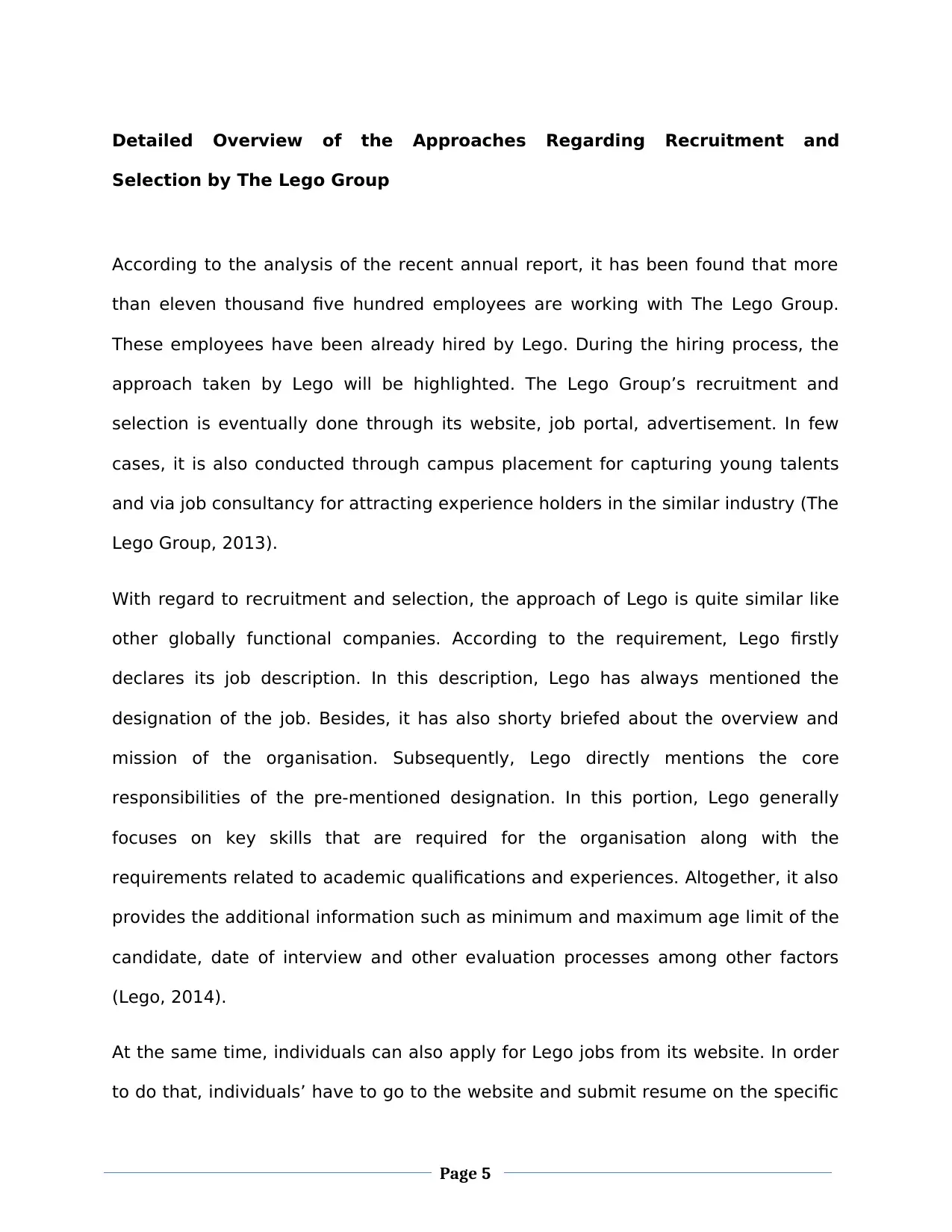
Detailed Overview of the Approaches Regarding Recruitment and
Selection by The Lego Group
According to the analysis of the recent annual report, it has been found that more
than eleven thousand five hundred employees are working with The Lego Group.
These employees have been already hired by Lego. During the hiring process, the
approach taken by Lego will be highlighted. The Lego Group’s recruitment and
selection is eventually done through its website, job portal, advertisement. In few
cases, it is also conducted through campus placement for capturing young talents
and via job consultancy for attracting experience holders in the similar industry (The
Lego Group, 2013).
With regard to recruitment and selection, the approach of Lego is quite similar like
other globally functional companies. According to the requirement, Lego firstly
declares its job description. In this description, Lego has always mentioned the
designation of the job. Besides, it has also shorty briefed about the overview and
mission of the organisation. Subsequently, Lego directly mentions the core
responsibilities of the pre-mentioned designation. In this portion, Lego generally
focuses on key skills that are required for the organisation along with the
requirements related to academic qualifications and experiences. Altogether, it also
provides the additional information such as minimum and maximum age limit of the
candidate, date of interview and other evaluation processes among other factors
(Lego, 2014).
At the same time, individuals can also apply for Lego jobs from its website. In order
to do that, individuals’ have to go to the website and submit resume on the specific
Page 5
Selection by The Lego Group
According to the analysis of the recent annual report, it has been found that more
than eleven thousand five hundred employees are working with The Lego Group.
These employees have been already hired by Lego. During the hiring process, the
approach taken by Lego will be highlighted. The Lego Group’s recruitment and
selection is eventually done through its website, job portal, advertisement. In few
cases, it is also conducted through campus placement for capturing young talents
and via job consultancy for attracting experience holders in the similar industry (The
Lego Group, 2013).
With regard to recruitment and selection, the approach of Lego is quite similar like
other globally functional companies. According to the requirement, Lego firstly
declares its job description. In this description, Lego has always mentioned the
designation of the job. Besides, it has also shorty briefed about the overview and
mission of the organisation. Subsequently, Lego directly mentions the core
responsibilities of the pre-mentioned designation. In this portion, Lego generally
focuses on key skills that are required for the organisation along with the
requirements related to academic qualifications and experiences. Altogether, it also
provides the additional information such as minimum and maximum age limit of the
candidate, date of interview and other evaluation processes among other factors
(Lego, 2014).
At the same time, individuals can also apply for Lego jobs from its website. In order
to do that, individuals’ have to go to the website and submit resume on the specific
Page 5
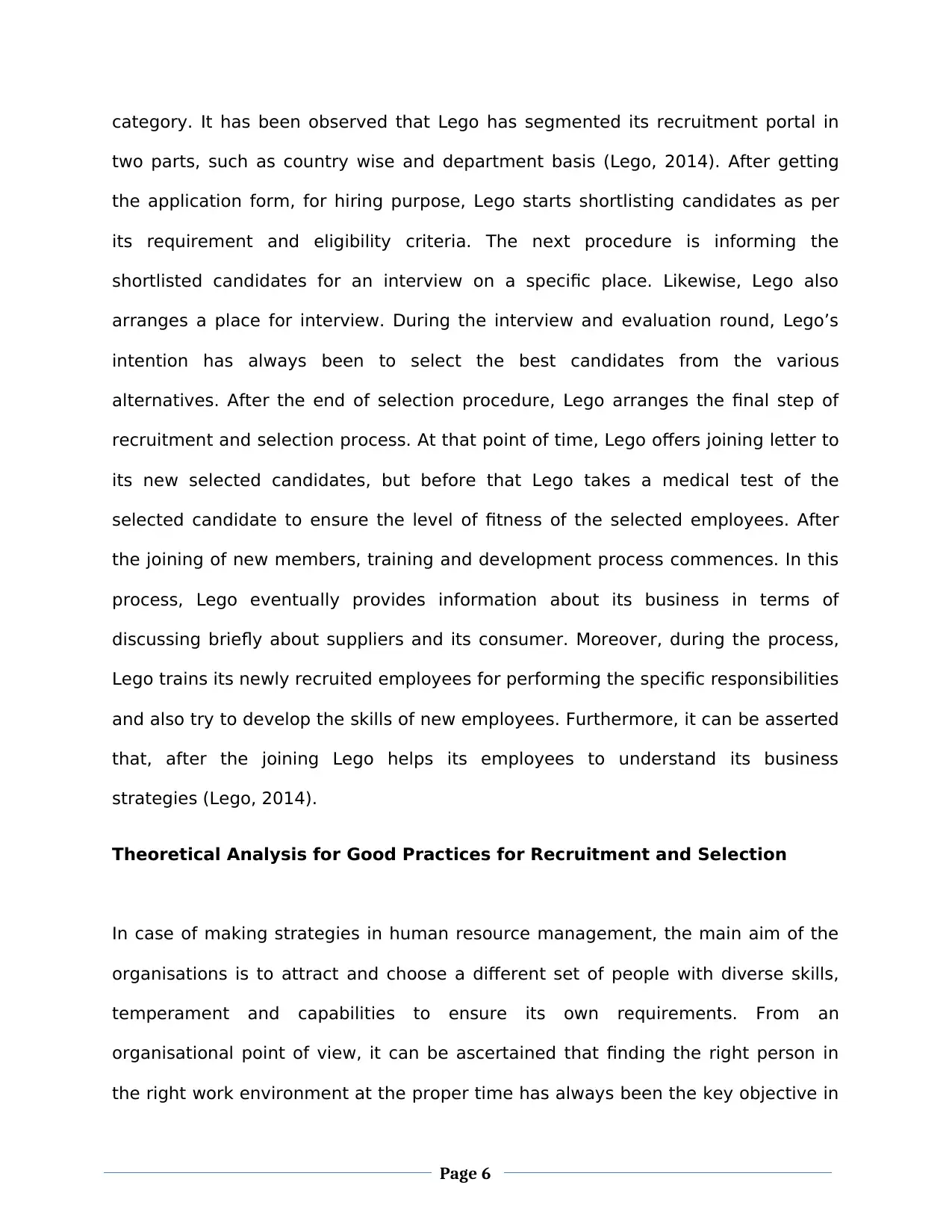
category. It has been observed that Lego has segmented its recruitment portal in
two parts, such as country wise and department basis (Lego, 2014). After getting
the application form, for hiring purpose, Lego starts shortlisting candidates as per
its requirement and eligibility criteria. The next procedure is informing the
shortlisted candidates for an interview on a specific place. Likewise, Lego also
arranges a place for interview. During the interview and evaluation round, Lego’s
intention has always been to select the best candidates from the various
alternatives. After the end of selection procedure, Lego arranges the final step of
recruitment and selection process. At that point of time, Lego offers joining letter to
its new selected candidates, but before that Lego takes a medical test of the
selected candidate to ensure the level of fitness of the selected employees. After
the joining of new members, training and development process commences. In this
process, Lego eventually provides information about its business in terms of
discussing briefly about suppliers and its consumer. Moreover, during the process,
Lego trains its newly recruited employees for performing the specific responsibilities
and also try to develop the skills of new employees. Furthermore, it can be asserted
that, after the joining Lego helps its employees to understand its business
strategies (Lego, 2014).
Theoretical Analysis for Good Practices for Recruitment and Selection
In case of making strategies in human resource management, the main aim of the
organisations is to attract and choose a different set of people with diverse skills,
temperament and capabilities to ensure its own requirements. From an
organisational point of view, it can be ascertained that finding the right person in
the right work environment at the proper time has always been the key objective in
Page 6
two parts, such as country wise and department basis (Lego, 2014). After getting
the application form, for hiring purpose, Lego starts shortlisting candidates as per
its requirement and eligibility criteria. The next procedure is informing the
shortlisted candidates for an interview on a specific place. Likewise, Lego also
arranges a place for interview. During the interview and evaluation round, Lego’s
intention has always been to select the best candidates from the various
alternatives. After the end of selection procedure, Lego arranges the final step of
recruitment and selection process. At that point of time, Lego offers joining letter to
its new selected candidates, but before that Lego takes a medical test of the
selected candidate to ensure the level of fitness of the selected employees. After
the joining of new members, training and development process commences. In this
process, Lego eventually provides information about its business in terms of
discussing briefly about suppliers and its consumer. Moreover, during the process,
Lego trains its newly recruited employees for performing the specific responsibilities
and also try to develop the skills of new employees. Furthermore, it can be asserted
that, after the joining Lego helps its employees to understand its business
strategies (Lego, 2014).
Theoretical Analysis for Good Practices for Recruitment and Selection
In case of making strategies in human resource management, the main aim of the
organisations is to attract and choose a different set of people with diverse skills,
temperament and capabilities to ensure its own requirements. From an
organisational point of view, it can be ascertained that finding the right person in
the right work environment at the proper time has always been the key objective in
Page 6
⊘ This is a preview!⊘
Do you want full access?
Subscribe today to unlock all pages.

Trusted by 1+ million students worldwide
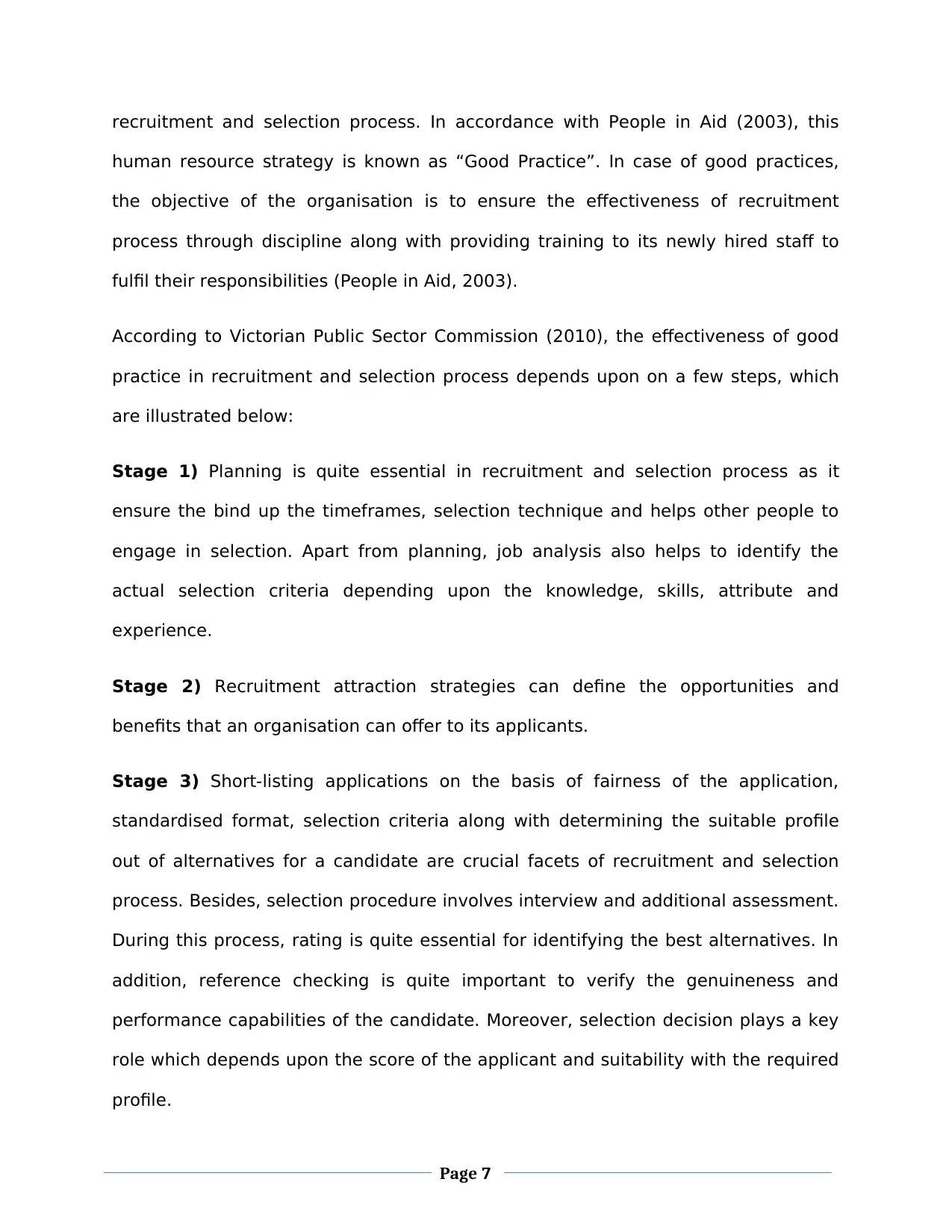
recruitment and selection process. In accordance with People in Aid (2003), this
human resource strategy is known as “Good Practice”. In case of good practices,
the objective of the organisation is to ensure the effectiveness of recruitment
process through discipline along with providing training to its newly hired staff to
fulfil their responsibilities (People in Aid, 2003).
According to Victorian Public Sector Commission (2010), the effectiveness of good
practice in recruitment and selection process depends upon on a few steps, which
are illustrated below:
Stage 1) Planning is quite essential in recruitment and selection process as it
ensure the bind up the timeframes, selection technique and helps other people to
engage in selection. Apart from planning, job analysis also helps to identify the
actual selection criteria depending upon the knowledge, skills, attribute and
experience.
Stage 2) Recruitment attraction strategies can define the opportunities and
benefits that an organisation can offer to its applicants.
Stage 3) Short-listing applications on the basis of fairness of the application,
standardised format, selection criteria along with determining the suitable profile
out of alternatives for a candidate are crucial facets of recruitment and selection
process. Besides, selection procedure involves interview and additional assessment.
During this process, rating is quite essential for identifying the best alternatives. In
addition, reference checking is quite important to verify the genuineness and
performance capabilities of the candidate. Moreover, selection decision plays a key
role which depends upon the score of the applicant and suitability with the required
profile.
Page 7
human resource strategy is known as “Good Practice”. In case of good practices,
the objective of the organisation is to ensure the effectiveness of recruitment
process through discipline along with providing training to its newly hired staff to
fulfil their responsibilities (People in Aid, 2003).
According to Victorian Public Sector Commission (2010), the effectiveness of good
practice in recruitment and selection process depends upon on a few steps, which
are illustrated below:
Stage 1) Planning is quite essential in recruitment and selection process as it
ensure the bind up the timeframes, selection technique and helps other people to
engage in selection. Apart from planning, job analysis also helps to identify the
actual selection criteria depending upon the knowledge, skills, attribute and
experience.
Stage 2) Recruitment attraction strategies can define the opportunities and
benefits that an organisation can offer to its applicants.
Stage 3) Short-listing applications on the basis of fairness of the application,
standardised format, selection criteria along with determining the suitable profile
out of alternatives for a candidate are crucial facets of recruitment and selection
process. Besides, selection procedure involves interview and additional assessment.
During this process, rating is quite essential for identifying the best alternatives. In
addition, reference checking is quite important to verify the genuineness and
performance capabilities of the candidate. Moreover, selection decision plays a key
role which depends upon the score of the applicant and suitability with the required
profile.
Page 7
Paraphrase This Document
Need a fresh take? Get an instant paraphrase of this document with our AI Paraphraser
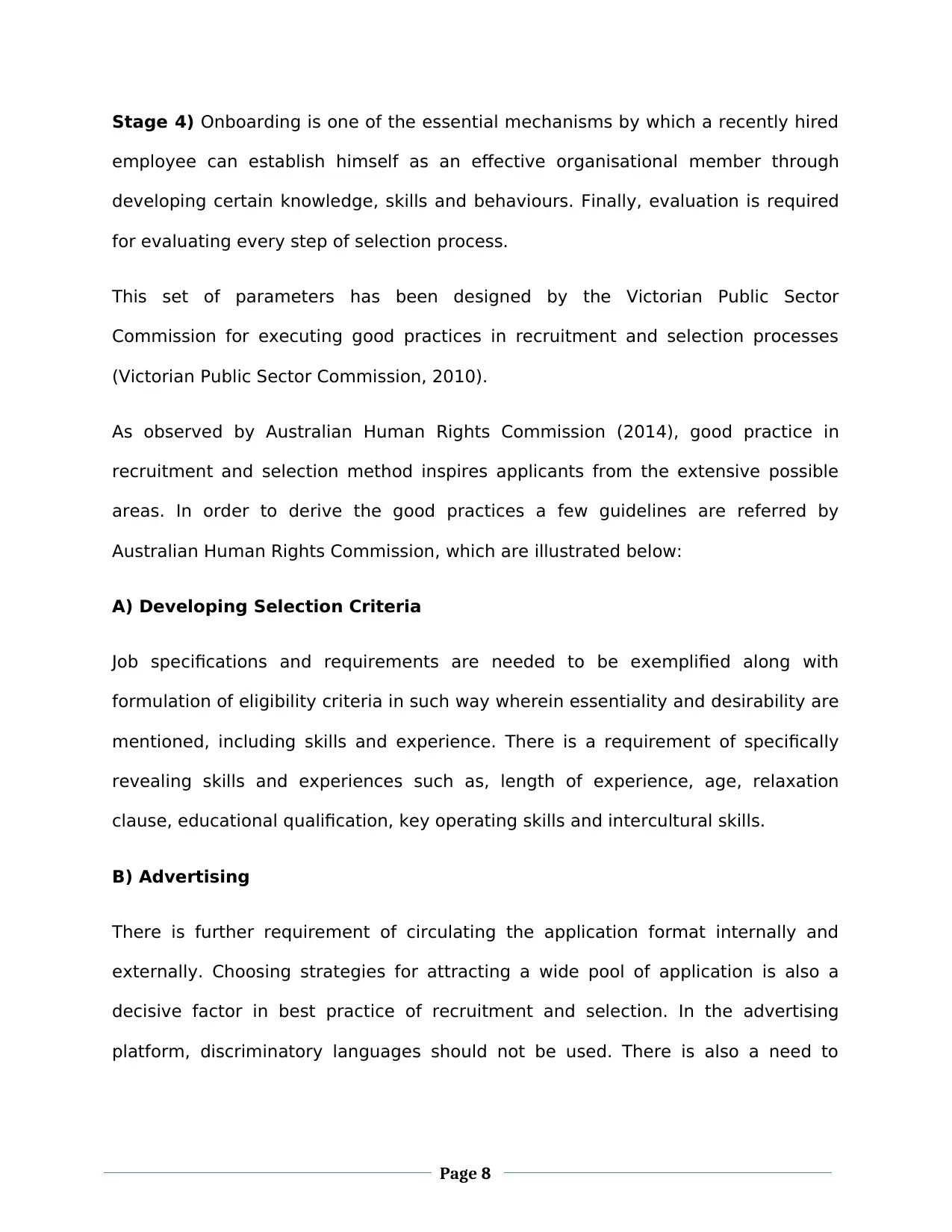
Stage 4) Onboarding is one of the essential mechanisms by which a recently hired
employee can establish himself as an effective organisational member through
developing certain knowledge, skills and behaviours. Finally, evaluation is required
for evaluating every step of selection process.
This set of parameters has been designed by the Victorian Public Sector
Commission for executing good practices in recruitment and selection processes
(Victorian Public Sector Commission, 2010).
As observed by Australian Human Rights Commission (2014), good practice in
recruitment and selection method inspires applicants from the extensive possible
areas. In order to derive the good practices a few guidelines are referred by
Australian Human Rights Commission, which are illustrated below:
A) Developing Selection Criteria
Job specifications and requirements are needed to be exemplified along with
formulation of eligibility criteria in such way wherein essentiality and desirability are
mentioned, including skills and experience. There is a requirement of specifically
revealing skills and experiences such as, length of experience, age, relaxation
clause, educational qualification, key operating skills and intercultural skills.
B) Advertising
There is further requirement of circulating the application format internally and
externally. Choosing strategies for attracting a wide pool of application is also a
decisive factor in best practice of recruitment and selection. In the advertising
platform, discriminatory languages should not be used. There is also a need to
Page 8
employee can establish himself as an effective organisational member through
developing certain knowledge, skills and behaviours. Finally, evaluation is required
for evaluating every step of selection process.
This set of parameters has been designed by the Victorian Public Sector
Commission for executing good practices in recruitment and selection processes
(Victorian Public Sector Commission, 2010).
As observed by Australian Human Rights Commission (2014), good practice in
recruitment and selection method inspires applicants from the extensive possible
areas. In order to derive the good practices a few guidelines are referred by
Australian Human Rights Commission, which are illustrated below:
A) Developing Selection Criteria
Job specifications and requirements are needed to be exemplified along with
formulation of eligibility criteria in such way wherein essentiality and desirability are
mentioned, including skills and experience. There is a requirement of specifically
revealing skills and experiences such as, length of experience, age, relaxation
clause, educational qualification, key operating skills and intercultural skills.
B) Advertising
There is further requirement of circulating the application format internally and
externally. Choosing strategies for attracting a wide pool of application is also a
decisive factor in best practice of recruitment and selection. In the advertising
platform, discriminatory languages should not be used. There is also a need to
Page 8
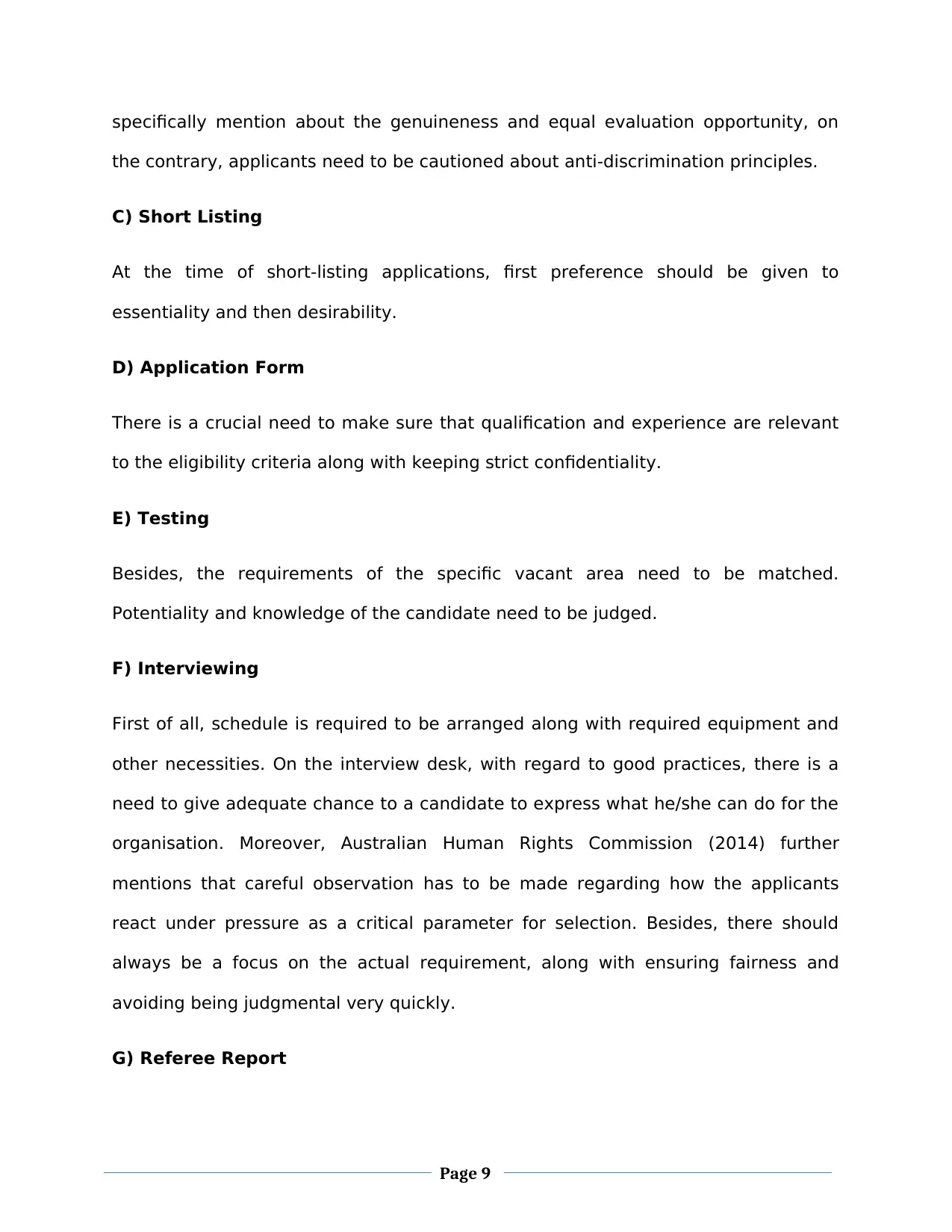
specifically mention about the genuineness and equal evaluation opportunity, on
the contrary, applicants need to be cautioned about anti-discrimination principles.
C) Short Listing
At the time of short-listing applications, first preference should be given to
essentiality and then desirability.
D) Application Form
There is a crucial need to make sure that qualification and experience are relevant
to the eligibility criteria along with keeping strict confidentiality.
E) Testing
Besides, the requirements of the specific vacant area need to be matched.
Potentiality and knowledge of the candidate need to be judged.
F) Interviewing
First of all, schedule is required to be arranged along with required equipment and
other necessities. On the interview desk, with regard to good practices, there is a
need to give adequate chance to a candidate to express what he/she can do for the
organisation. Moreover, Australian Human Rights Commission (2014) further
mentions that careful observation has to be made regarding how the applicants
react under pressure as a critical parameter for selection. Besides, there should
always be a focus on the actual requirement, along with ensuring fairness and
avoiding being judgmental very quickly.
G) Referee Report
Page 9
the contrary, applicants need to be cautioned about anti-discrimination principles.
C) Short Listing
At the time of short-listing applications, first preference should be given to
essentiality and then desirability.
D) Application Form
There is a crucial need to make sure that qualification and experience are relevant
to the eligibility criteria along with keeping strict confidentiality.
E) Testing
Besides, the requirements of the specific vacant area need to be matched.
Potentiality and knowledge of the candidate need to be judged.
F) Interviewing
First of all, schedule is required to be arranged along with required equipment and
other necessities. On the interview desk, with regard to good practices, there is a
need to give adequate chance to a candidate to express what he/she can do for the
organisation. Moreover, Australian Human Rights Commission (2014) further
mentions that careful observation has to be made regarding how the applicants
react under pressure as a critical parameter for selection. Besides, there should
always be a focus on the actual requirement, along with ensuring fairness and
avoiding being judgmental very quickly.
G) Referee Report
Page 9
⊘ This is a preview!⊘
Do you want full access?
Subscribe today to unlock all pages.

Trusted by 1+ million students worldwide
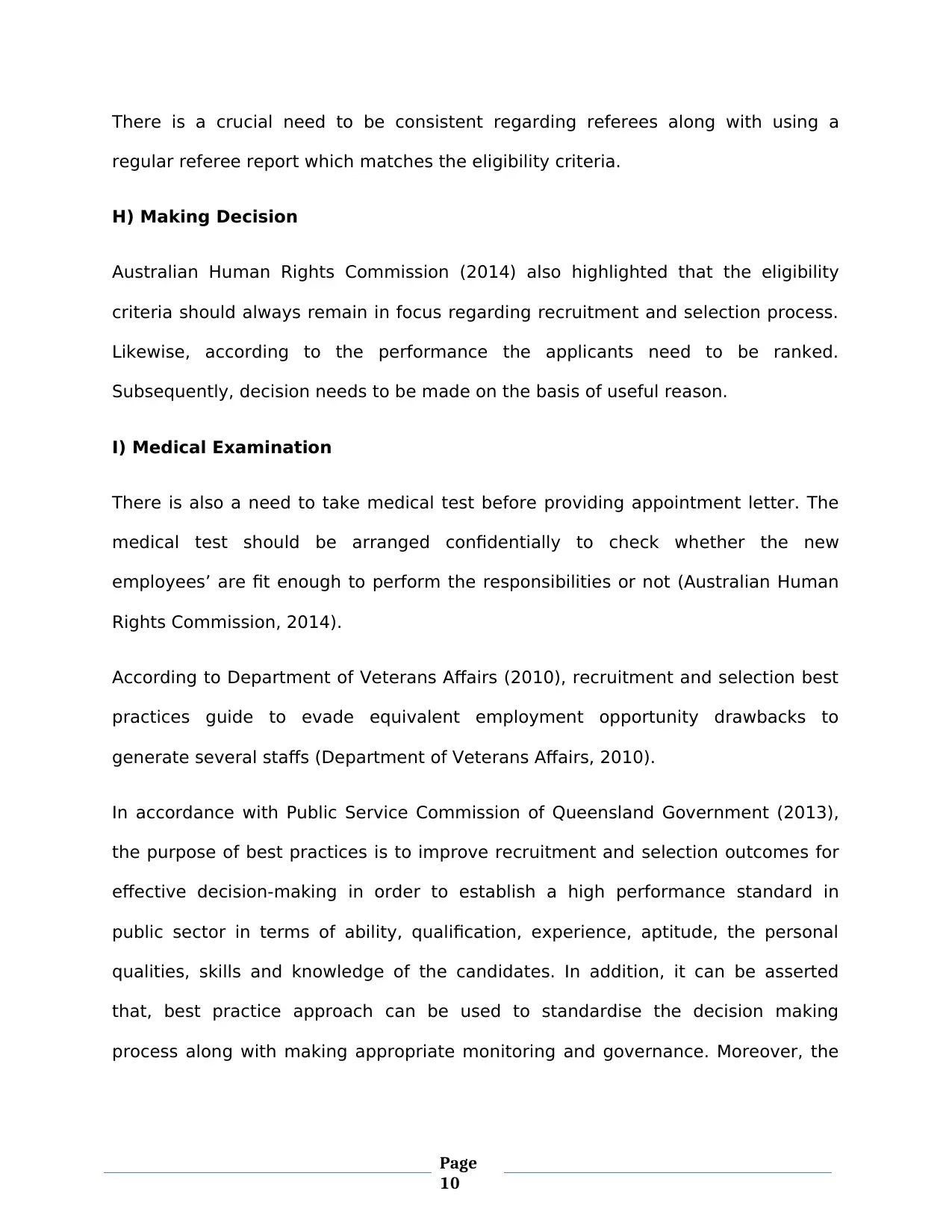
There is a crucial need to be consistent regarding referees along with using a
regular referee report which matches the eligibility criteria.
H) Making Decision
Australian Human Rights Commission (2014) also highlighted that the eligibility
criteria should always remain in focus regarding recruitment and selection process.
Likewise, according to the performance the applicants need to be ranked.
Subsequently, decision needs to be made on the basis of useful reason.
I) Medical Examination
There is also a need to take medical test before providing appointment letter. The
medical test should be arranged confidentially to check whether the new
employees’ are fit enough to perform the responsibilities or not (Australian Human
Rights Commission, 2014).
According to Department of Veterans Affairs (2010), recruitment and selection best
practices guide to evade equivalent employment opportunity drawbacks to
generate several staffs (Department of Veterans Affairs, 2010).
In accordance with Public Service Commission of Queensland Government (2013),
the purpose of best practices is to improve recruitment and selection outcomes for
effective decision-making in order to establish a high performance standard in
public sector in terms of ability, qualification, experience, aptitude, the personal
qualities, skills and knowledge of the candidates. In addition, it can be asserted
that, best practice approach can be used to standardise the decision making
process along with making appropriate monitoring and governance. Moreover, the
Page
10
regular referee report which matches the eligibility criteria.
H) Making Decision
Australian Human Rights Commission (2014) also highlighted that the eligibility
criteria should always remain in focus regarding recruitment and selection process.
Likewise, according to the performance the applicants need to be ranked.
Subsequently, decision needs to be made on the basis of useful reason.
I) Medical Examination
There is also a need to take medical test before providing appointment letter. The
medical test should be arranged confidentially to check whether the new
employees’ are fit enough to perform the responsibilities or not (Australian Human
Rights Commission, 2014).
According to Department of Veterans Affairs (2010), recruitment and selection best
practices guide to evade equivalent employment opportunity drawbacks to
generate several staffs (Department of Veterans Affairs, 2010).
In accordance with Public Service Commission of Queensland Government (2013),
the purpose of best practices is to improve recruitment and selection outcomes for
effective decision-making in order to establish a high performance standard in
public sector in terms of ability, qualification, experience, aptitude, the personal
qualities, skills and knowledge of the candidates. In addition, it can be asserted
that, best practice approach can be used to standardise the decision making
process along with making appropriate monitoring and governance. Moreover, the
Page
10
Paraphrase This Document
Need a fresh take? Get an instant paraphrase of this document with our AI Paraphraser
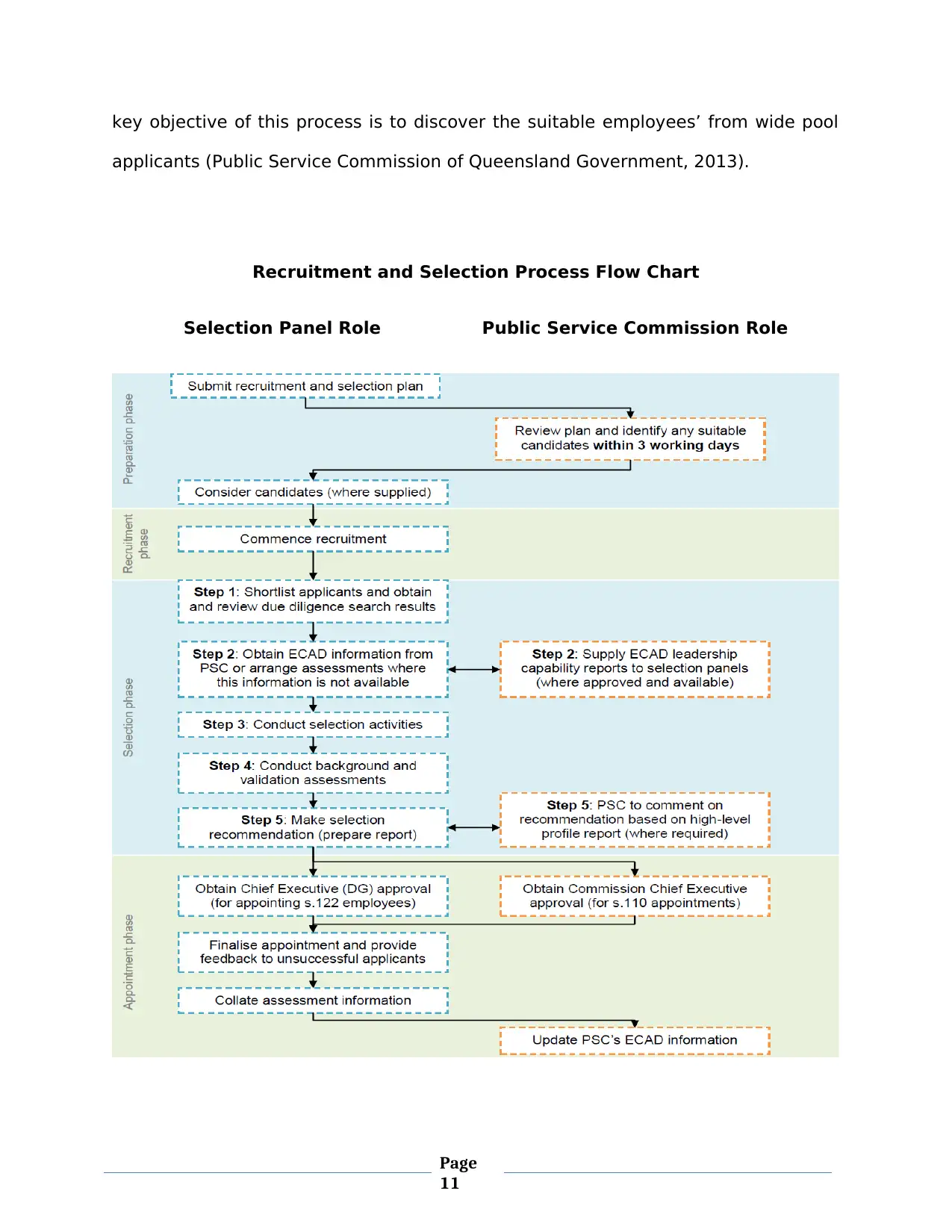
key objective of this process is to discover the suitable employees’ from wide pool
applicants (Public Service Commission of Queensland Government, 2013).
Recruitment and Selection Process Flow Chart
Selection Panel Role Public Service Commission Role
Page
11
applicants (Public Service Commission of Queensland Government, 2013).
Recruitment and Selection Process Flow Chart
Selection Panel Role Public Service Commission Role
Page
11
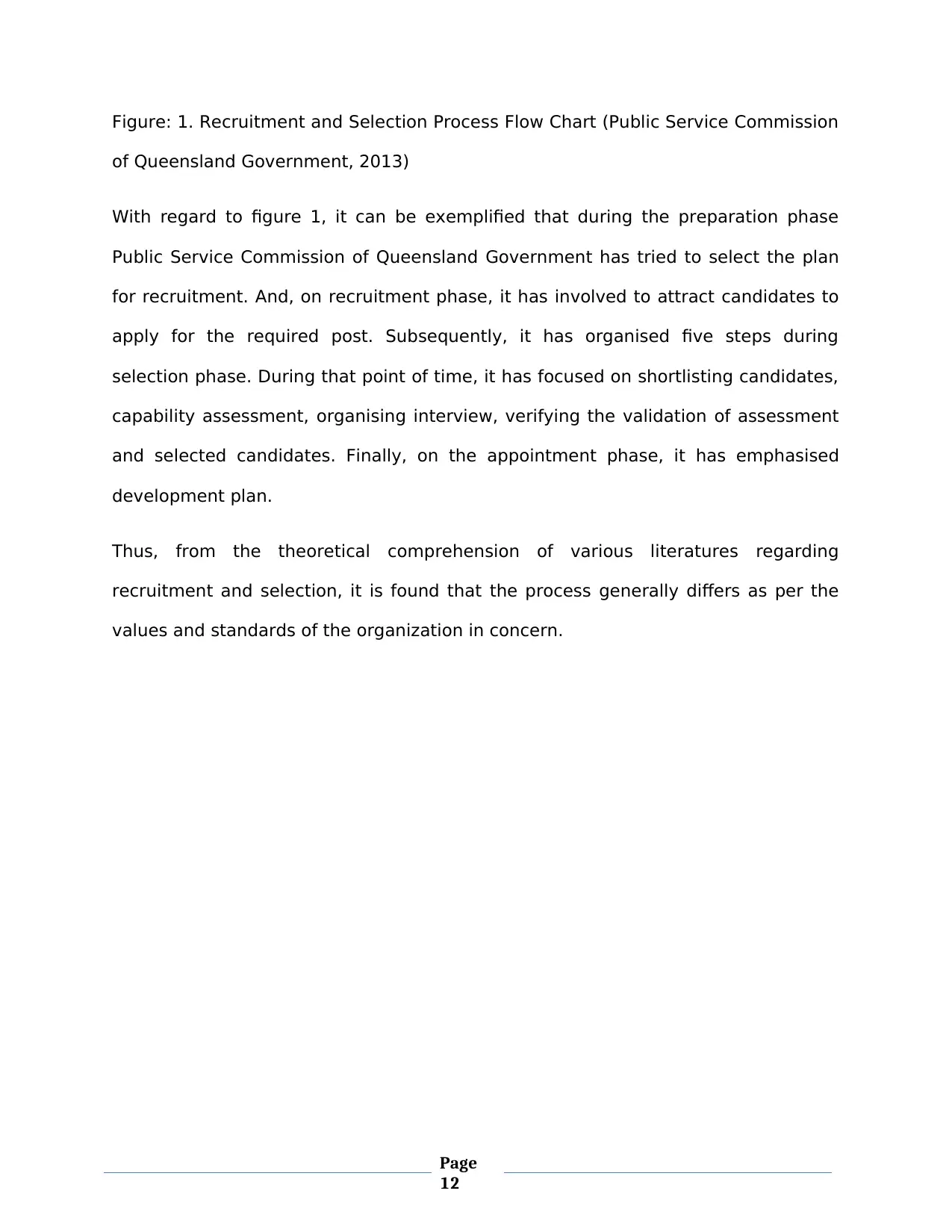
Figure: 1. Recruitment and Selection Process Flow Chart (Public Service Commission
of Queensland Government, 2013)
With regard to figure 1, it can be exemplified that during the preparation phase
Public Service Commission of Queensland Government has tried to select the plan
for recruitment. And, on recruitment phase, it has involved to attract candidates to
apply for the required post. Subsequently, it has organised five steps during
selection phase. During that point of time, it has focused on shortlisting candidates,
capability assessment, organising interview, verifying the validation of assessment
and selected candidates. Finally, on the appointment phase, it has emphasised
development plan.
Thus, from the theoretical comprehension of various literatures regarding
recruitment and selection, it is found that the process generally differs as per the
values and standards of the organization in concern.
Page
12
of Queensland Government, 2013)
With regard to figure 1, it can be exemplified that during the preparation phase
Public Service Commission of Queensland Government has tried to select the plan
for recruitment. And, on recruitment phase, it has involved to attract candidates to
apply for the required post. Subsequently, it has organised five steps during
selection phase. During that point of time, it has focused on shortlisting candidates,
capability assessment, organising interview, verifying the validation of assessment
and selected candidates. Finally, on the appointment phase, it has emphasised
development plan.
Thus, from the theoretical comprehension of various literatures regarding
recruitment and selection, it is found that the process generally differs as per the
values and standards of the organization in concern.
Page
12
⊘ This is a preview!⊘
Do you want full access?
Subscribe today to unlock all pages.

Trusted by 1+ million students worldwide
1 out of 19
Related Documents
Your All-in-One AI-Powered Toolkit for Academic Success.
+13062052269
info@desklib.com
Available 24*7 on WhatsApp / Email
![[object Object]](/_next/static/media/star-bottom.7253800d.svg)
Unlock your academic potential
Copyright © 2020–2025 A2Z Services. All Rights Reserved. Developed and managed by ZUCOL.





